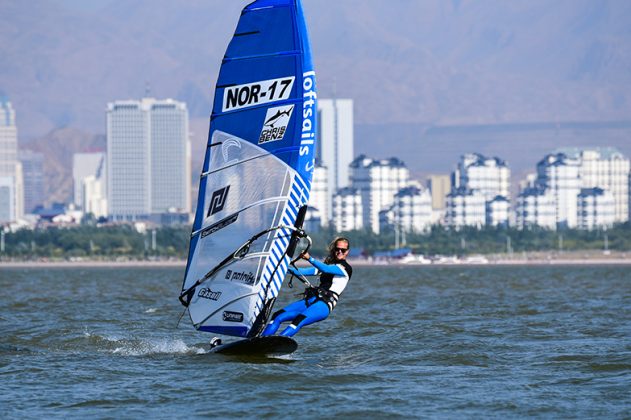Inner Mongolia is an autonomous region of northern China, bordering both the Republic of Mongolia and Russia. Far from the coast, it isn’t the first place in the world you think of for windsurfing, but intrepid Norwegian windsurfer Miriam Rasmussen travelled there to compete in a race and explore the sailing around the city of Wuhai, located on the Yellow River between the Gobi and Ordos deserts. Read on as Miriam gives us an insight into the area, it’s windsurfing and how China is embracing our sport.
This feature originally appeared in the January / February 2019 issue of Windsurf Magazine.
Words Miriam Rasmussen // Photos Pål Fostervold
We’re in Wuhai, Inner Mongolia, waiting for the desert thermals to kick in. Of all the unlikely places in the world I would find myself waiting for wind in order to go windsurfing, Inner Mongolia is ranking pretty high. When I received the invitation to participate in the first Wuhai international kite and windsurf race, I did some research before I answered. It turns out that the Yellow river runs through the city of Wuhai on its way to the ocean. A barrier construction north of the city slows the river down to form the Wuhai lake. Light but reliable winds swoop down from the surrounding desert and thus provide the necessary conditions for windsport devotees. The local windsurfing community is small, but very resourceful. In fact, they even convinced the city authorities and the government that windsurfing should be developed as a part of the tourist industry in the area.
BIG
China’s economy has been booming for several decades. Honouring the strong socialist traditions of the country, China spends a mindboggling amount of money to improve its infrastructure and to lift the standard of living for its citizens. The result is a growing middle class looking for hobbies. After spending a week in China, I realised anything the Chinese pursue, they do in a very big way. And when I say big, I mean very very big! So when the authorities decide to host a windsurfing race at Wuhai lake, they start off by inviting 100 participants. We are all accommodated in a 5-star hotel on the beach, all expenses paid. Every participant received a finishing fee that was greater than the prize money at most national events anywhere else. In just two weeks they built a huge pavilion for the event, and bought enough gear for all the participants to use! Choose between the Starfish setup, or the Starboard one, slalom or formula gear! Ceremonies, excursions, PWA style prize money and massive media coverage are the results of the astronomical budget set aside to make this event happen. Not since the golden era of windsurfing in the eighties has the world’s windsurfing scene seen anything like this. Chinese sailing clubs buy boards in the hundreds, straight off the bat. Representatives from various windsurfing brands are here, broad smiles all around, asking themselves where this is heading. The situation is as unpredictable as the potential is enormous.
“PWA style prize money and massive media coverage are the results of the astronomical budget set aside to make this event happen.”
MARKET
Windsurfing production for international markets has been going on in China for years, but now brands find themselves looking at China not only as a manufacturer, but as a potential market. Winston Goh from Oxbold sports comments, “I have the dealership for Starboard and Severne for eastern Asia and sell quite a lot of gear to China. The Chinese market is not very big yet, as windsurfing is a small sport. I don’t think that we will see the Chinese market explode like we saw in Europe in the eighties, mainly because the season is too short. But if we continue to share the joy of windsurfing here, I think we will see a steady growth of sales.”
Jeff Henderson from Hot Sails Maui has his own thoughts, “The potential of the Chinese market is by sheer numbers theoretically huge. The Chinese are finding new recreational activities, windsurfing being one of them. To optimise the potential I believe it’s wise to take one step back and look at what happened in Europe and the US in the eighties, when windsurfing was huge with millions of units sold every year. A fact most people seem to have forgotten is that 9 out of 10 windsurfers never planed. When the sport evolved, and the gear became more extreme, windsurfing collapsed as a mass activity, as only a few were able to handle it. Svein Rasmussen’s “Go” board redefined windsurfing when it came, and probably saved us from extinction. I think its both possible and wise to start in China where we lost it in the eighties – offer them affordable gear on which you can have fun in normal conditions and go for volumes, not extremes. The event here in Wuhai is a great example of this, riders from all over China and Asia gather to compete, planing or non-planing. The fun is the same and their winner instinct is ferocious! If windsurfing catches on in China, this can have a huge positive impact on the industry. There are signs that parts of the industry is starting to acknowledge the need for low threshold, affordable products in order to ensure the recruitment of new windsurfers. The relaunch of the classic windsurfer is a great example of this.”
“Now brands find themselves looking at China not only as a manufacturer, but as a potential market.”
EXPLORE
We enjoyed 5 nice days here, of which 4 came with winds from 12 to 20 knots, so we had a lot of fun on foils and light wind slalom gear. Exploring the lake, we found some amazing contrasts between the urban Wuhai skyline on the east bank and the Gobi sand dunes on the west bank of the river. The city made a windsurfing facility on the bank in just a couple of weeks, with a floating launching facility and a ceremony platform with storage for windsurfing gear underneath. Just a stone’s throw away from a 5-star hotel, this is the best place to explore the lake of Wuhai from.
“We found some amazing contrasts between the urban Wuhai skyline on the east bank and the Gobi sand dunes on the west bank of the river.”
EAST AND WEST
The Chinese have an ambiguous relationship with the West, on the one hand its looks and culture are idolised, but on the other the West poses a threat to their culture. The chances that you will run into any kind of trouble or unpleasantness in Wuhai is virtually zero as the government has hard sentences for any kind of criminality towards foreigners. Indeed I have never experienced such a level of hospitality and friendliness. We all felt a little like rock stars at the event as when we cruised by the spectator packed waterfront, the crowds cheered like crazy, and we all spent hours each day posing for photographs.
While the plane is taxiing out on the runway, I lean back in my seat, close my eyes and think back on a very exciting and exotic week in Inner Mongolia. Whether windsurfing catches on in Wuhai or not, I will always be the first Scandinavian woman to have windsurfed the Yellow river, and I will make sure my grandchildren know that! Next time they throw a party here, I’ll let you know on my social media so we can all have an adventure in Inner Mongolia!
“We all felt a little like rock stars at the event.”
FACT BOX
Getting there: Fly to Wuhai from Beijing or Yinchuan, the closest neighbouring city with a major regional airport. Yuanchin is a 3 hour car drive to Wuhai.
Language: Download a translator on your app before you go as foreign language speakers are rare.
Visa: Start applying for a Chinese visa in good time before leaving as it can be a lengthy and meticulous process; we had to return to the embassy three times to get it all right!
Driving: Rules are improvised as you go along. Hence a taxi ride here is full of surprises. On the upside there’s not a lot of traffic, so your chances of survival are good! The most challenging part of driving for a visitor in China is that all the signs are in Chinese. Together with improvised road construction solutions and random driving patterns, I wouldn’t advise anyone to drive themselves here!
Food: Wuhai is clean and well run in the urban areas we saw. You can eat and drink whatever you want (and you are likely to be served whatever you can imagine in your wildest food fantasies as anything remotely digestible is on the menu!). It’s smart to practise eating with chopsticks before you leave, as western cutlery can be scarce. Bring your own chocolate and coffee as they are also hard to come by.
The spot: We were sailing from the waterfront beside the XTMDJ Xingtai New Century Grand hotel to the south of the city. For sure, staying at this 5-star hotel will make your stay here a very easy one. It’s also possible though to access the lake from the dunes to the west, where there’s a beautiful recreational area. There are no hotels or infrastructure there though, so you would need a car. The lake is a fascinating place to go windsurfing. With the Wuhai skyline on one side, and the Gobi desert on the other, your view can change from 100% urban to 100% desolate in an instant. To the north there’s a massive bridge which looks very imposing but is super cool to approach. The lake is big, so the reaches are very long and you can cross the lake…and I recommend doing so! The winds are quite reliable, but rarely very strong, mostly in the 10-20 knot range so foiling or light wind slalom gear are best suited. The mighty Yellow river that feeds the lake, has its colour from the sands of the Gobi, so the water is literally yellow! Up the river there’s a very nice spot where you can launch from a sandy beach and the waters are shallow, but you don’t get the visual contrast between the dunes and Wuhai’s skyline. Lying at an altitude of 1300m in Inner Mongolia, the summer is short in Wuhai and the winter is harsh. You will however find nice temperatures, around 17-25 °C. here from May to October.
FOLLOW MIRIAM
For more of Miriam Rasmussen check out her social media:
Instagram – @miriam_rasmussen_windsurfing and www.facebook.com/ptmiriam
















